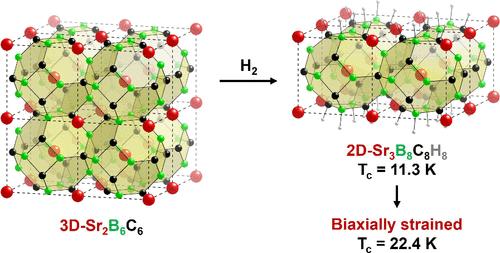Single-Layer Clathrane: A Potential Superconducting Two-Dimensional Hydrogenated Metal Borocarbide
IF 9.1
1区 材料科学
Q1 CHEMISTRY, MULTIDISCIPLINARY
引用次数: 0
Abstract
We propose a new family of two-dimensional (2D) metal borocarbide clathrane superconductors derived from three-dimensional (3D) MM′B6C6 clathrates. First-principles calculations reveal that hydrogen passivation and surface metal decoration stabilize the M2M′B8C8H8 monolayers. These 2D systems exhibit tunable superconductivity governed by hole concentration, structural anisotropy, and electron–phonon coupling. We find that in-plane anisotropy competes with superconductivity, reducing Tc despite favorable doping. Biaxial strain mitigates this anisotropy, enhances Fermi surface nesting, and increases Tc by an average of 15.5 K. For example, the Tc of Sr3B8C8H8 is predicted to increase from 11.3 to 22.2 K with strain engineering. These findings identify 2D clathranes as promising, strain-tunable superconductors and highlight design principles for optimizing low-dimensional superconducting materials.

单层笼烷:一种潜在的超导二维氢化金属硼碳化物
我们提出了一种新的二维(2D)金属硼碳化物笼形超导体,源自三维(3D) MM 'B6C6笼形物。第一性原理计算表明,氢钝化和表面金属修饰使M2M 'B8C8H8单层膜稳定。这些二维系统表现出由空穴浓度、结构各向异性和电子-声子耦合控制的可调谐超导性。我们发现面内各向异性与超导性相竞争,尽管有利的掺杂也降低了Tc。双轴应变减轻了这种各向异性,增强了费米表面嵌套,并使Tc平均增加了15.5 K。以Sr3B8C8H8为例,通过应变工程预测其Tc从11.3 K增加到22.2 K。这些发现确定了二维笼烷是有前途的、应变可调的超导体,并强调了优化低维超导材料的设计原则。
本文章由计算机程序翻译,如有差异,请以英文原文为准。
求助全文
约1分钟内获得全文
求助全文
来源期刊

Nano Letters
工程技术-材料科学:综合
CiteScore
16.80
自引率
2.80%
发文量
1182
审稿时长
1.4 months
期刊介绍:
Nano Letters serves as a dynamic platform for promptly disseminating original results in fundamental, applied, and emerging research across all facets of nanoscience and nanotechnology. A pivotal criterion for inclusion within Nano Letters is the convergence of at least two different areas or disciplines, ensuring a rich interdisciplinary scope. The journal is dedicated to fostering exploration in diverse areas, including:
- Experimental and theoretical findings on physical, chemical, and biological phenomena at the nanoscale
- Synthesis, characterization, and processing of organic, inorganic, polymer, and hybrid nanomaterials through physical, chemical, and biological methodologies
- Modeling and simulation of synthetic, assembly, and interaction processes
- Realization of integrated nanostructures and nano-engineered devices exhibiting advanced performance
- Applications of nanoscale materials in living and environmental systems
Nano Letters is committed to advancing and showcasing groundbreaking research that intersects various domains, fostering innovation and collaboration in the ever-evolving field of nanoscience and nanotechnology.
 求助内容:
求助内容: 应助结果提醒方式:
应助结果提醒方式:


